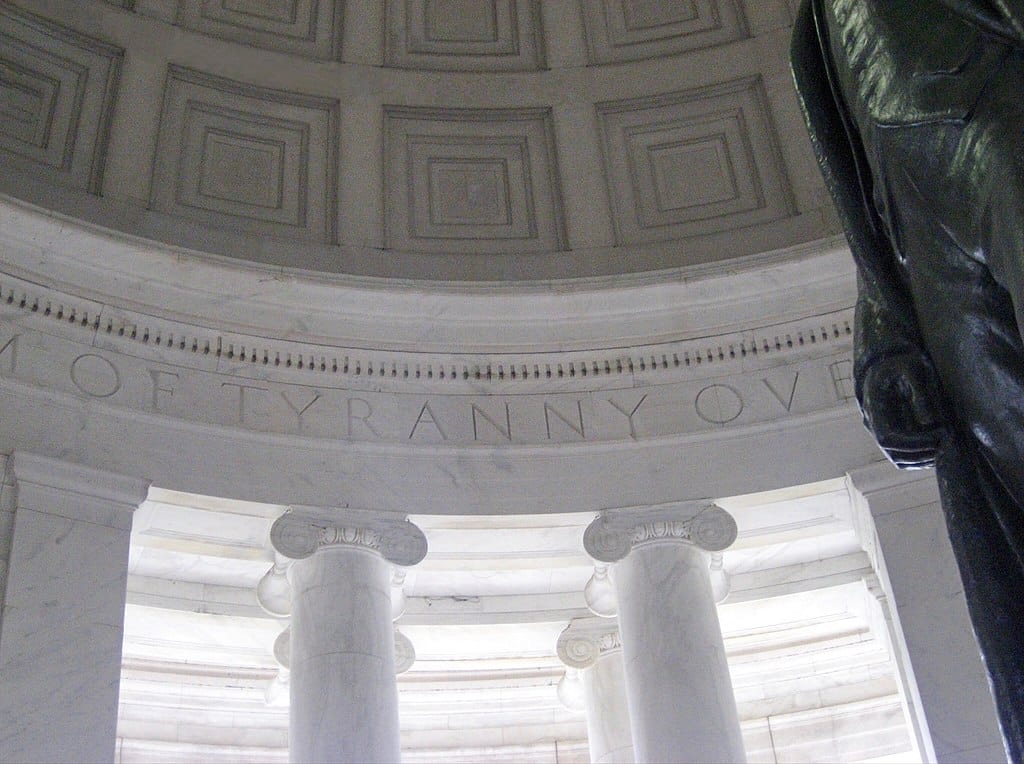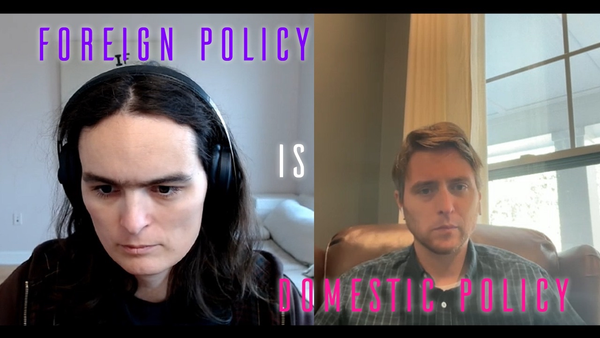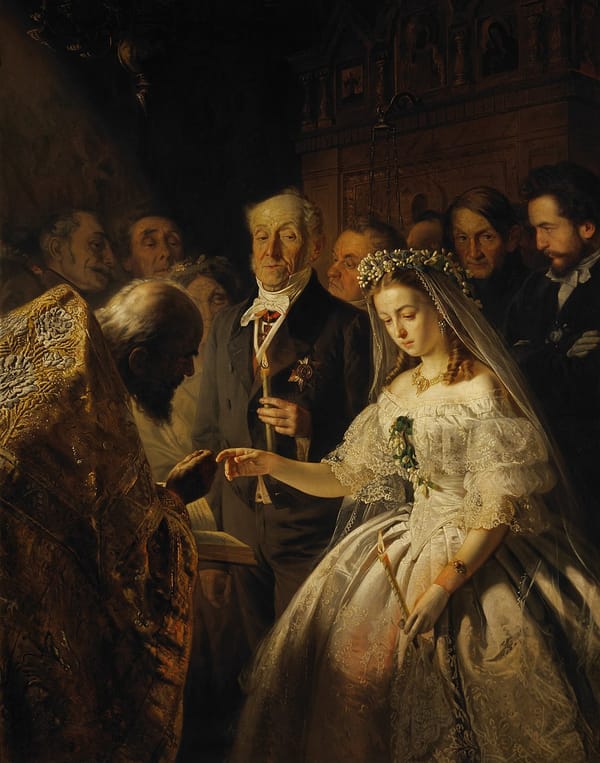The American Presidency Can Never Be Trusted Again
It’s time for multiparty democracy and a limited executive.

In his February 5th piece titled There is No Going Back, New York Times columnist Jamelle Bouie concluded after the first days of Trump’s second term:
[We] cannot expect a return to the Constitution as it was. Whatever comes next, should the country weather this attempted hijacking, will need to be a fundamental rethinking of what this system is and what we want out of it. Anything less will set us up for yet another Trump . . .
We cannot go back to anything approaching the old constitutional order, which already had been in a long, terminal decline. There is a deep distrust—both in the US and abroad; left and right—in the American presidency. By extension, this includes Congress and the courts, especially the Supreme Court. The long decline in the US constitutional order, little-by-little then seemingly all at once, isn’t new and many observers have noted it. Trump has only supercharged its decline. MAGA has exposed its rickety foundations of norms and long-gone, favorable conditions.
It's inevitable that it will be replaced—either in actual written form or by becoming an irrelevant dead letter like other authoritarian regimes.
Should we get the chance for the former, whether through an electoral win by a pro-democracy popular front or following a total collapse, we must institute a multiparty democracy (via proportional representation like most democracies) and an executive more like a prime minister than the imperial president we seem doomed to endure under our current constitution.
The runaway presidency, unconstrained by a legislature or the courts
No President has been forced from office via the constitutional system of Impeachment and Removal in nearly a quarter of a millennium. Even the first impeachment and trial of Andrew Johnson after the Civil War broke along party lines, and the impeachments of the last 50 plus years have predictably done the same. The one exception, Nixon’s preemptive resignation, was followed quickly by Ford’s pardon of him.
In hindsight, this set the stage for not just the abuse of the pardon power, but the notion that the American President is imbued with extensive powers and immunities that would scarcely be recognizable by the founders and stand in contrast to the more limited, collective authority of parliamentary democracies’ executives.
The ideal of the limited executive, who Madison in the federalist papers called a “chief magistrate,” was never perfect. Its powers increased during wars but decreased during periods of Congressional and judicial activity. The mindset of a limited president seems to have long left the imagination, with Democrats and Republicans alike envisioning them as the all-powerful actor in our system.
The rise of the imperial presidency has been feared for some time. Arthur Schlesinger Jr., who wrote “The Imperial Presidency” in the aftermath of Vietnam and Nixon, also speculated what we need to do to get out of the imperial frame of mind:
But what kept a strong President constitutional, in addition to checks and balances incorporated within his own breast, was the vigilance of the nation. Neither impeachment nor repentance would make much difference if the people themselves had come to an unconscious acceptance of the imperial Presidency.
We often have grown to see the Presidency as a savior—a kind of benevolent Napoleon or Tribune of the People. We need to do more than just get checks and balances back. We also need to have a system that permanently enshrines a limited executive whose power derives from a robust multiparty legislature.
The presidency needs reform, and Americans must consider ways — however implausible they may seem in the context of today’s politics — to get there . . . But how we get there is, frankly, hard to fathom. – Jack Goldsmith, May 5, 2025 in the New York Times
In his May 5th New York Times OpEd We Have to Deal With Presidential Power, Jack Goldsmith explains that Trump’s assumption of authoritarian presidential power did not occur in a vacuum. Rather, presidents in recent decades—faced with a Congress unable or unwilling to act, with elections on a knife’s edge—have increasingly usurped unilateral power and degraded constitutional norms. His list is familiar but informative: the stretching of statutory authority in areas like tariffs and immigration, pardon abuse, rule by decree through executive orders, making statutorily independent agencies beholden to the President, and open non-enforcement of federal law.
It’s clear that the Supreme Court cannot come to the rescue; SCOTUS has been stacked with devotees of unilateral presidential power by GOP presidents. But more importantly, the Anglo-American form of common law jurisprudence is inherently reactionary. Across the spectrum of judicial thinking is a devotion to the concepts of ripeness and standing, which limits when federal courts can get involved in many of the usurpations we are experiencing under Trump.
The root of the matter is the power of the presidency itself and the recession of Congressional power to constrain it. In parliamentary systems like Germany, the UK, or Italy, for instance, the head of government, the Prime Minister, may command a lot of political power if their coalition has a good majority. But the Prime Minister holds that power from the political consent and confidence of the legislature and their collegiality with their cabinet. In the British system, the formal executive authority is actually held by the Crown. Of course, King Charles III exercises no independent initiative of his own, but that separation ensures that Keir Starmer can have no pretension to executive authority but what his cabinet and majority gives him. Similarly, presidents of Germany and Italy also perform the ceremonial functions that the English monarchs do. They also provide formal executive approval of government decisions and exercise some very limited authority of their own under their constitutions in case of emergencies or failures to form a government.
Congress permanently in the shadow of the presidency
There has been some back and forth with Congressional atrophy over the centuries, especially related to war and particular personalities in the White House and Capitol Hill. But the consistent trend over the past several decades has been a steady abdication of Congress’s role in governance, policy initiation, budgeting, and so on.
When either the House or Senate are in opposition to the President, they are increasingly powerless to initiate policy or scrutinize the administration as they once could when the two parties were fluid coalitions. Even when they are the same party as the President, POTUS is now the prime initiator of budgetary and policy initiative. This was not particularly true before this century. Today, most members of Congress defer to the White House and are content with an advisory, almost sinecure, role. Especially in the GOP, this subservient role supporting the President in the media is now expected.
Lee Drutman’s “Breaking the Two-Party Doom Loop: The Case for Multiparty Democracy in America” argues that much of the functionality of Congress stemmed from the structure of American political parties as fluid coalitions. Democrats had many conservatives wary of the welfare state and civil rights, such as Strom Thurmond. Republicans had their northeastern liberals like Jacob Javits and Nelson Rockefeller who were as liberal as most any democrat on social programs. Unlike today, the parties once had considerable policy overlap. Those fluid coalitions were able to maneuver to pass legislation. Often, the minority party was on the winning side of a legislative fight.
This system, which Drutman lauds to some extent, was actually derided by American political scientists of an earlier generation. In a now infamous 1950 paper, “Toward a More Responsible Two-Party System,” in the journal of the American Political Science Association, the authors advocated for two “responsible” parties—firmly differentiated as to what policies they supported.
They seemed to pine for parties with concise ideologies and manifestos like they found in Europe. Of course, those systems were multiparty—a crucial variable that the authors oddly overlooked.
In a perverse way, we are where the APSA writers wanted us to be in 1950—we have two political parties with no overlap. What they seemed not to understand was that the system of Presidentialism—the separation of the executive and legislative functions—cannot work with just two, widely separated parties. In the design of the 1787 constitution, Congress and the President must cooperate to run the government (budgetary authorizations, appropriations, and other laws). In the 19th century, legislative lapses were also ameliorated by the limited reach of a much smaller government. Even without the filibuster, the US Senate is a wildly undemocratic body. If this system with so many veto points and disproportionalities worked in the past, it was because coalitions could be formed across party lines—a multiparty system of sorts embedded in the two parties.
American two partyism: calcified politics, weak parties who can’t control their labels, and the Frankenstein coalition
In The Bitter End: The 2020 Presidential Campaign and the Challenge to American Democracy (2022), Sides, Tausanovitch, and Vavreck note how American politics has become calcified, that is, “stiff, rigid, and painful.” It is polarization “plus” according to their research, where winner-take-all elections are combined with a country on a knife’s edge, nearly evenly divided. With a small swing from the last election, either party could gain a larger majority in the House and win the Presidency, the ultimate winner-take-all prize.
The authors marshal data showing that opinion polls on the presidency and voting intentions hardly moved at all despite the enormous news stories in 2020. The large swings of a few generations ago—Reagan’s 49 states and 60%+ of the vote—seem like a distant world now.
There’s a connection between The Bitter End’s calcification concept and our calcified constitution. Other democracies are facing right wing, authoritarian politics, but ours is uniquely unsuited to the age we live in. And flowing from it are levels of democratic backsliding, authoritarianism, and policy stasis that our peers are not experiencing. Our calcified politics are largely downstream of the constitution and our electoral system—the former is being caused largely by the later two.
The Primary Election is thought of as a bulwark against elite control of the two parties and was sold as such more than a century ago by Progressive Era reformers. Progressive reformers didn’t like the American party system they found and for good reason: people only had two effective choices in the general. Interestingly, there was a burst of temporary proportional representation reform for municipal legislatures that occurred in the first decades of the 20th century that is now mostly forgotten. For the most part, progressives enacted two reforms: Primary elections (state legislatures and Congress) and non-partisan elections (many states’ municipal elections).
In the former case, anyone without paying a single due or having any association with the party can take its name in an election (the primary) and spend significant time and money communicating who they are to the primary electorate. In the latter case (non-partisan elections), the burden of communicating what a candidate stands for is even higher without a party label.
In an important sense this makes America’s two political parties fundamentally weak, as the main job of a political party in most of the world, attaching names to candidates, is closed to them. Democrat and Republican officials do try to support certain candidates in the primaries, and perhaps their choices usually win the primaries, but they spend considerable time and money on primary candidate selection. They must pick sides in intraparty infighting, which leads to even more distrust of the party. And they often fail, as Donald Trump’s rise attests.
You’d expect more than two parties, or at least some regional ones, in a country of nearly 350 million. But the cold hard political incentives of single winner districts with primaries and Presidentialism obstructs third party formation across this vast land.
To some extent political parties outside the US have some input by “dues paying” members in constituencies or districts for candidate selection. For instance, in the UK, the Labour and Conservative central offices will give local constituency associations a list of candidates they can select from. Later, the party can kick a rebel legislator out of the party, making them unable to run under the party label in the next election.
The inability of parties to legally control candidate selection is an odd, defining feature of the American system. Some argue that this makes actual political parties illegal. Even if that conclusion goes too far, it can’t be emphasized enough how strange the legal regime of American political parties is. In mature democracies, the political party is a “private” organization where dues paying members are a minority of the population, perhaps as low as 1.5% of the UK population, for instance. The government “registering” your affiliation or so-called membership, as is done in most US states, is very peculiar.
Two parties is too few. Fifteen is too many. Maxwell Stearns, author of Parliamentary America, likes the mixed-member proportional form of proportional representation used in Germany with a 5% of the nationwide vote cut-off for parties to get members in the legislature. That seems to cleanly get you five or six parties in the legislature, with two of them a large-ish pair of center-right and center-left parties. Those two parties comfortably get around 30-40% of the vote, with some swings cycle-to-cycle. Germany, in particular, has been able to give the far right their “fair” representation without letting them take over government as they have in the U.S.
There seems to be something intuitively right about this political behavior and unnatural about the need to cobble together a Frankenstein pre-election coalition to get 50%. It is near impossible now to get barely more than 50% of Americans to vote for the GOP or Democrats—for President or across the whole House’s 435 seats. Our system forms odd bedfellows coalitions at best.
On the Democratic side you have a wildly overbroad group held together by their support for democracy, pluralism, and opposition to Trumpian authoritarianism—views that should be held by multiple parties, not just one of the two. Disagreement over who constitutes a legitimate “member” of the Democratic Party underscores its character as a broad, uneasy coalition rather than a coherent organization.
The meme “The European mind cannot comprehend this” has been going around social media lately and it describes how odd this American arrangement is. Because in the UK, Germany, or Italy, for instance, being a party “member” is actually a formal thing you pay dues for and can be kicked out of.
If you try to join the UK Conservative (or Labour, or LibDem) Party as a basic member, they can reject you for your published political views or prior party membership (they actually investigate). And they can kick you out for violating the above once a member, as outlined in their “Code of Conduct”. By contrast, you or I having “by right” access to the party label next to our name on an American primary ballot is like saying a Blackberry has a right to be in the iPhone primary election, And if it wins, Blackberries are the standard-bearer for iPhones in the November election.
At worst, in the case of Trump, it means that normie Republicans must share their tent with him and his extreme right, anti-democratic retinue. And they cannot dispense with Trump’s voters because, even if only a few percent of the electorate are hardcore for Trump, to lose them means losing everything in the next election. Under a strict two-party system, no pre-election constituency can be excluded.
The hard question isn’t the 2 points that would’ve decided the election. It’s how to build a Democratic Party that isn’t always 2 points away from losing to Donald Trump — or worse. – New York Times’ Ezra Klein on X, Nov. 11, 2024
Much of the energy of center-left public intellectuals like Ezra Klein is spent trying to explain how Democrats could cobble together 50% plus one of the two-party votes. This is a very unnatural political regime, maintained only by our rigid adherence to single member districts and primaries. Democrats and Republicans could easily get 40% of the vote, without requiring a single campaign expenditure, with just ballot access alone.
Other institutional choices—multipartyism and a “responsible” executive
Unless your schooling included some study of comparative government, you probably never learned that other kinds of “electoral systems” exist, or given much thought to how our own actually works. Even a high school AP Government curriculum never mentions it.
Proportional representation aims to make the legislature’s composition proportional to the vote for the party. So, if 10% of voters vote for candidates of party X, then party X gets 10% of the seats. This contrasts completely with our single member district system, where multiparty formation is inhibited because of Duverger’s Law, which notes that the incentive structure of single member districts’ electoral systems largely prevents party formation above two.
The mechanics of proportional representation, from the ballot design—what you see on the ballot paper, a party name, a candidate with a party name, both, or something else—to the way votes are counted vary. There are different “families” of systems as well: Party List, Single Transferable Vote (STV, also known as Proportional Ranked Choice Voting), and Mixed Member Proportional Representation (MMP).1
The English and the Americans didn’t really understand the British constitution that evolved from the 17th century Glorious Revolution. That is, until a London banker and founder of The Economist began explaining it and its contrast to Presidentialism.
It was Walter Bagehot in 1865 who first explained what the UK constitution had evolved into. He dismissed the pomp and circumstance of the Monarchy, the House of Lords, and the aristocracy that most notice when they think of England. He divided the British system into the “Dignified”, the “powdered wig” regime mentioned above, and the “Efficient” part. The efficient part was the Prime Minister, the Cabinet, and the House of Commons. This fusion of executive and legislative was extremely efficient in his view. He contrasts it with the contradictions and inefficiencies of the US constitution and Presidentialism in terms that are, amazingly, mostly still spot on nearly one and three-quarters centuries later.
Much of the later work of creating “purposeful” parliamentary republics—countries ruled by Prime Ministers possessing ceremonial presidents with limited reserve powers—owes its origins to England and Bagehot’s enduring explanation of it.
Maxwell Stearns puts together both multipartyism and an American “prime minister”
Just months before Trump’s reelection, University of Maryland law professor Maxwell Stearns published Parliamentary America: The Least Radical Means of Radically Repairing Our Broken Democracy. It is the only major work I’ve found that combines proportional representation and converting the American president into a Prime Minister, though Stearns still proposes calling him or her President.
Stearns calls the Madisonian edifice embodied in the first three articles of the constitution a “rock, paper, scissors” system. To paraphrase the Federalist Papers, ambition checks ambition. The comparison to a game is intentionally derisive, because he argues that this is a cherished myth about how our constitution works and has been wrong since the founding. Some of the conditions that allowed them to work fairly well, (as Lee Drutman also discussed in his Doom Loop), have faded into the past. Parties formed quickly after the country's founding. The institutional jealousies the Federalist Papers had hoped for gave way to partisanship. Stearns notes that we have had three constitutional crises: the period after the American Revolution before the constitution’s adoption, the Civil War and Reconstruction, and now.
He advocates for a multi-party system and for the President to be chosen by an enlarged multi-party House in the manner of a Prime Minister as in many other countries. Stearns’ proposal is the "German" (and New Zealand) form of Mixed Member Proportional (MMP) where voters vote for both a single member district House member and for a party preference. He also calls for the ability to remove the President by a 60% no confidence style vote of the House of Representatives. His proposals come in the form of three amendments: Parliamentary Election of the President, Proportional Representation (and doubling the size of the House), and Presidential Removal.
We cannot go back to the old order, and it wasn’t that great anyways
Juan Linz’s 1990 essay “The Perils of Presidentialism” found that the vast majority of stable democracies are parliamentary, where the executive is selected by, and depends on the confidence of, the legislature. He admitted that the US was different though – our parties were diffuse and ideologically diverse, the electorate was overwhelmingly moderate and punitive towards both Goldwaters and McGoverns. POTUS candidates he concluded were strongly incentivized to stay away from the extremes.
What was read in 1990 as a truism about the American government is read 35 years later as long gone.
As Jamelle Bouie argues, there’s no going back, and it wasn’t that great anyways. The liberal advances that the other democracies made since the end of World War II—the welfare state, equitable healthcare, infrastructure, etc.—have been stymied by our unique structures of minority rule that have shaped the GOP into an anti-system, anti-progress party in a way that other countries’ center right parties, like the UK conservatives and the German CDP-CSU, are not. Those parties have basically accepted the need for the liberal state, if simply to limit its growth and maintain national cohesion. The incentives our constitution provides for conflict versus theirs for consensus play no small part.
Constitutional reform is now inevitable, good or bad
Disappointingly, many still cling to the idea that our Constitution can still work against an authoritarian party determined to make it a dead letter. Obama tends to make uninspiring arguments about Madisonianism and the need for both sides to be more centrist and responsible.
Samantha Hancox-Li recently called this the “fantasy of regular politics.” “The fundamental rules and norms of American politics are no longer the unquestioned structure of politics, but themselves objects of political contestation,” she concludes. The authoritarian right fully embraces the revolutionary nature of their project. Pro-democracy forces should as well.
A reformed constitution, along the lines of Stearns and Goldsmith’s thinking, should end the Imperial Presidency’s excesses and restore a genuinely limited executive. This could include curtailing the pardon power, restoring Congress’s legislative veto over executive actions, and making the attorney general and the U.S. attorney system independent of the president. It could also repeal the Executive Vesting Clause and transfer the Office of Management and Budget to Congress’s own budget office. Together, these reforms would dismantle the imperial machinery that has allowed successive presidents to act as quasi-sovereigns rather than constitutional officers.
Equally important, the president should become a true prime minister—chosen by and accountable to Congress. Stearns proposes a 60 percent threshold for removal to ensure stability, though even a simple majority for both installation and removal could suffice. What matters most is that the executive’s legitimacy flow from the legislature’s confidence, not from a separate national plebiscite. The title itself—whether “President” or “Prime Minister”—is ultimately neither here nor there. The South African President, for instance, functions as a parliamentary prime minister, while the leaders of Spain and Italy bear the title “President” despite operating within parliamentary systems.2 The essence lies in accountability, not nomenclature.
Finally, the United States must break free from its calcified two-party structure through proportional representation in an enlarged House of Representatives.
The road to a Farewell to Arms
The slow, painful decline of the U.S. evokes historical parallels with modern nations like Chile, Hungary, or Turkey to be sure. But the US, unlike them, is a continental-sized country of 340 million, the third largest in the world, with vast cultural, economic, and military resources. The historical mind finds the last years of the Roman Republic evocative, particularly the tumultuous period spanning from the Gracchi brothers through Sulla to Augustus. Like Germany after Weimar or China within a few years after World War II, a US turn to authoritarianism I fear would rock the world and pose a threat to humanity itself.
Against this vast sweep of history, the constitution’s steep hill to amend it is placed in context. From Maxwell Stearns’s Independence Day 2025 blog post:
I believe that once enough members of two deeply damaged teams realize that they are one election away—not just from losing power, but from doing so repeatedly and with ever-growing stakes to an increasingly intolerant faction on the other side—we will see an opportunity to come together.
Endnotes
1. If you want to take a deep dive on these systems, the two most important works explaining electoral systems and executive power (prime minister versus president) in a democracy are: Patterns of Democracy: Government Forms and Performance in Thirty-Six Countries (2012) by Arend Lijphart, and A Different Democracy: American Government in a 31-Country Perspective (2014) by Taylor, Shugart, Lijphart, and Grofman
For a very deep dive on electoral systems or coffee table use, take a look at The Oxford Handbook of Electoral System (2021) by Shugart.
STV/P-RCV form of PR has been repeatedly introduced since 2017 into the House by Virginia Representative Don Beyer (D), most recently just several weeks ago.
2. In the Italian and Spanish languages the term is "Presidente . . . " Their titles have long been mistranslated into English as "Spanish/Italian Prime Minister X"
Featured image is Jefferson Memorial rotunda “against every form of tyranny over the mind of man”, by Gr8shpr





